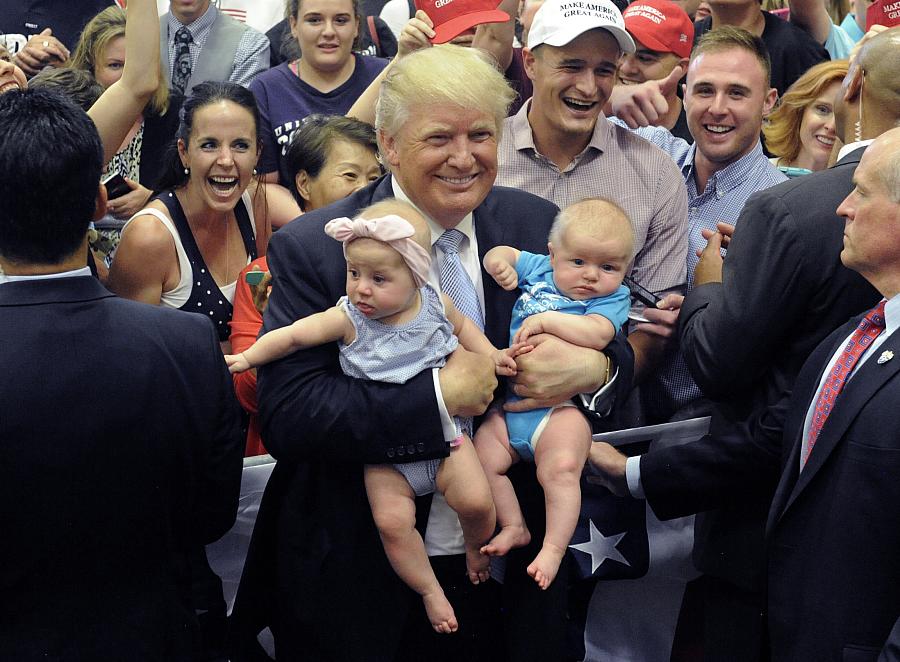The candidates field questions on children’s health, but have we learned anything?

Photo: Jason Connolly/Getty Images
One of the recurring themes of this presidential election is what might be called the policy gulf. Or as the Los Angeles Times put it in a headline last month, “Clinton has enough policy to fill a book, while Trump has said little about how he'd govern.”
That includes health policy. The New England Journal of Medicine recently asked both candidates: “What specific changes in policy do you support to improve access to care, improve quality of care, and control health care costs for our nation?” In a preface to Clinton’s 1,500-word policy statement, the editors note: “Secretary Clinton responded. Mr. Trump did not respond.”
But the American Academy of Pediatrics had more success in getting both candidates to respond to four questions on what they would do to better children’s health. True to their respective styles, Clinton’s answer to AAP’s final question alone (427 words) was longer than Trump’s entire response (416 words). So what do we actually learn in this ongoing battle of expansiveness versus brevity?
There are a few noteworthy — if not entirely new — tidbits from a children’s health perspective:
- Trump credits the Children’s Health Insurance Program with expanding insurance coverage for children, but thinks it “should be streamlined with funds being block-granted to the states.”
That’s in line with Trump’s broader call to “block-grant Medicaid to the states.” Proponents of the idea (most recently featured in the Romney-Ryan platform in 2012) say it would give states far more flexibility and help curb costs. Critics of the proposal, which would provide annual lump sums to states, point to recent studies from the Urban Institute and the left-leaning Center on Budget and Policy Priorities, which say the approach would create big funding disparities between states while “block grants’ basic structure makes them especially vulnerable to funding reductions over time.”
From a political perspective, Trump’s praise of CHIP for expanding coverage is interesting, given Clinton’s often-mentioned role in the program’s creation in 1997 as First Lady.
- Trump says that “repealing and replacing the Affordable Care Act” should result in “fewer people needing CHIP and Medicaid.”
The Republican candidate doesn’t explain how that would work, and he hasn’t yet fleshed out what his Obamacare replacement would look like. But an analysis this spring from the nonpartisan Committee for a Responsible Federal Budget found Trump’s health care plan would cause about 21 million people to lose coverage, and cost $270 billion more than sticking with Obamacare.
- Clinton says she “will allow families to buy health insurance on the health exchange, regardless of their immigration status.”
That would mark a break from current policy, which excludes undocumented immigrants for buying insurance on the health exchanges. California, however, approved legislation earlier this year that could make it the first state in the nation to allow undocumented immigrants to buy unsubsidized insurance on the state exchange; the waiver request is currently pending approval from the Obama administration. This spring, California began enrolling low-income undocumented children in full-scope Medicaid, one of a handful of blue states to have done so.
- Clinton vows to “work with governors and legislators” to expand Medicaid in the 19 states that have not done so. “There are approximately a quarter of a million children who are uninsured and have a parent that falls within this coverage gap,” Clinton wrote. “By expanding coverage, we are not only helping the parents, but the children who depend on them.”
That quarter-of-a-million estimate can be found in a Kaiser Family Foundation report issued earlier this year on those remaining in the “coverage gap.” As that brief notes, there is a strong association between parents and children when it comes to health coverage. “Research has found that parent coverage in public programs is associated with higher enrollment of eligible children, so these children may be hard to reach if their parents continue to be ineligible for coverage,” the KFF report states. (This blog has written about the “welcome mat” effect before here and here.)
- Clinton wants to expand funding for federally qualified health centers and rural clinics: While this proposal isn’t specific to children nor new, Clinton reiterates her pledge to “double the funding for primary care services at these centers, expanding funding over $40 billion over the next 10 years.” How this will be paid for isn’t spelled out.
- Clinton reiterates her support for universal preschool and expanding Early Head Start. Obama has been pushing his plan for universal preschool since 2013, but his efforts have been largely thwarted by Congress. If recent signals from the Republican Party are any indication, such proposals are unlikely to find bipartisan support in Congress any time soon.
Unless that same Congress finds the balance of power fundamentally reshaped by the current election, of course.

